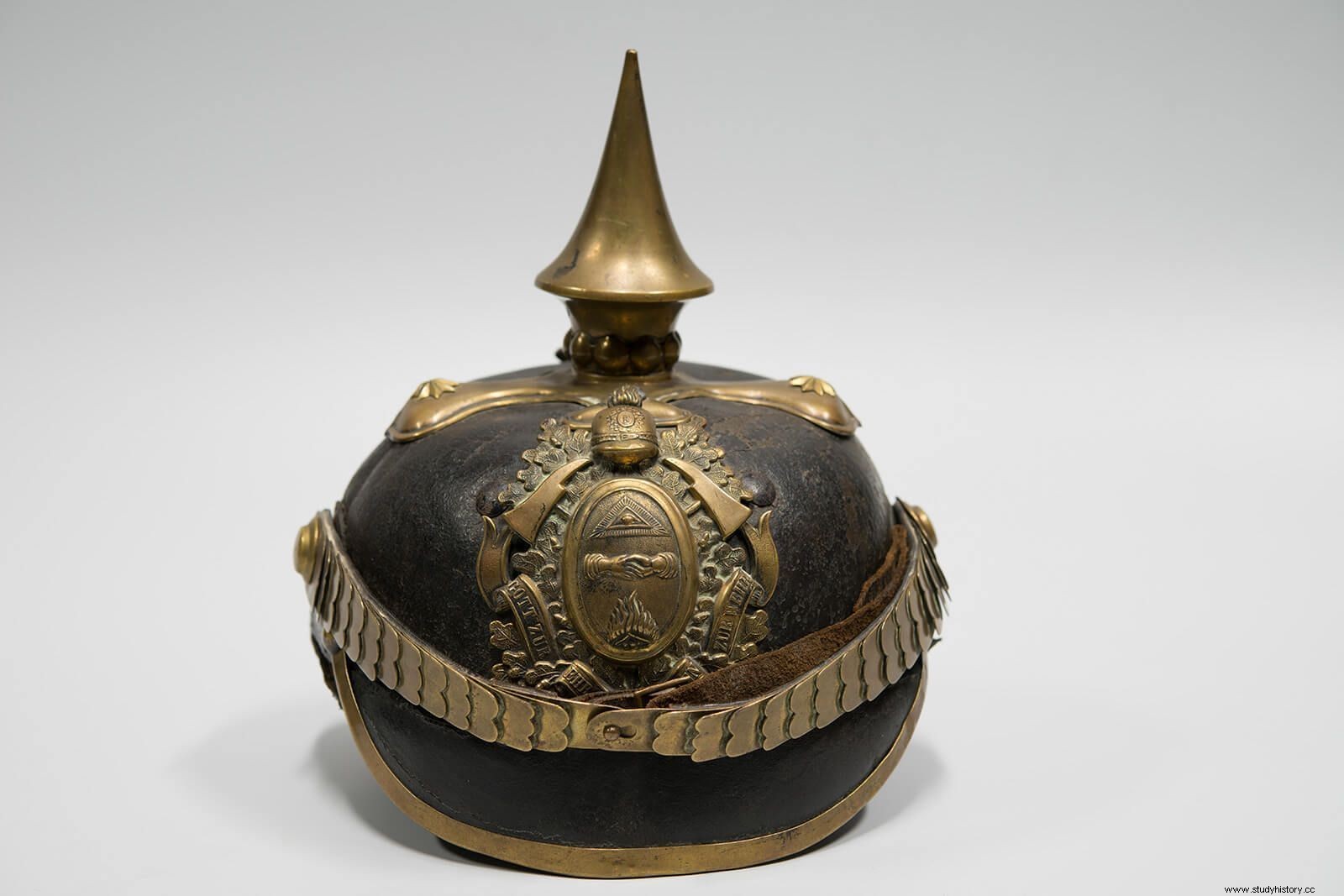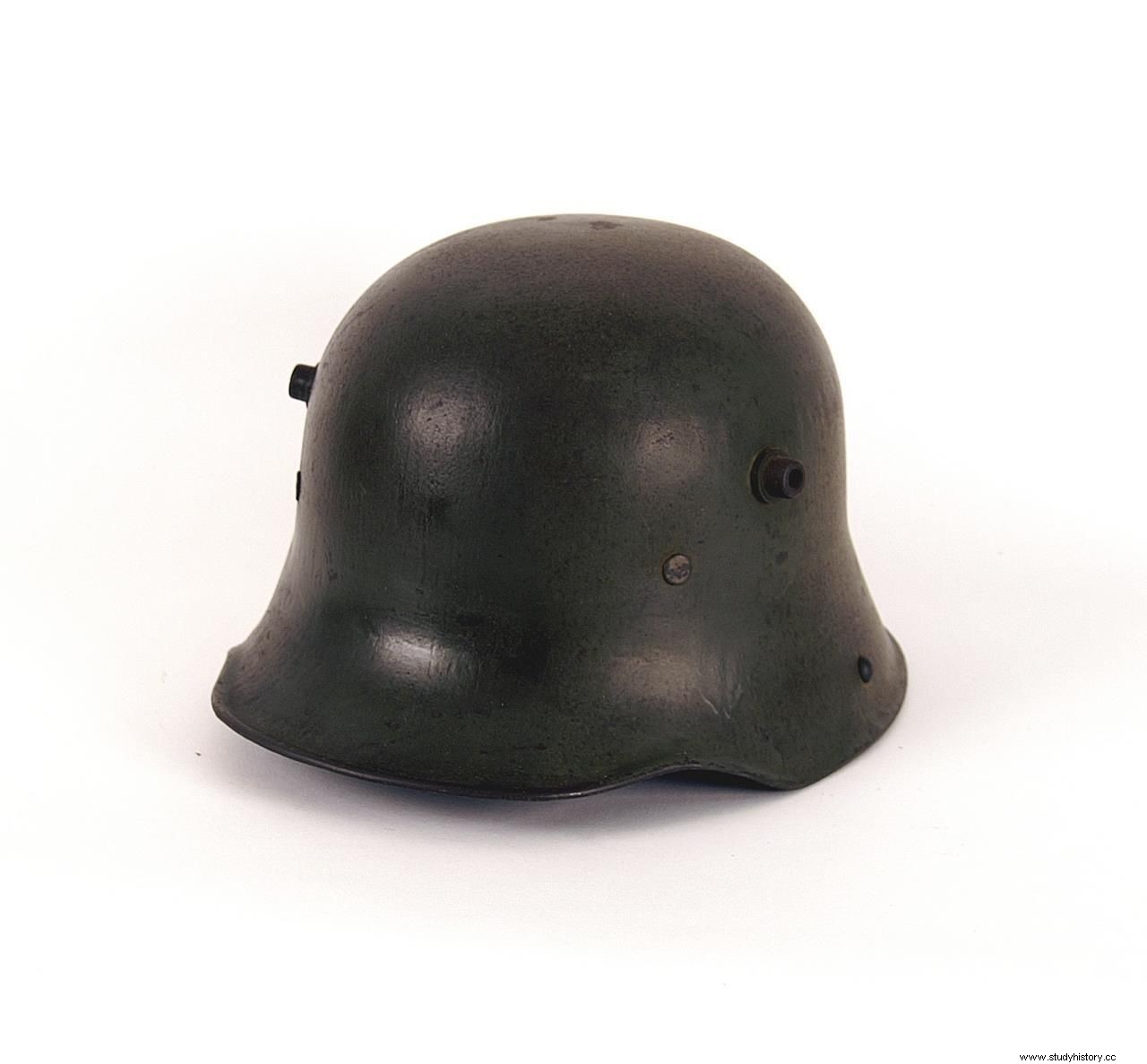
The advances of the Industrial Revolution put at the service of the war machine led to the development of weapons capable of inflicting devastating losses on armies. Trench warfare revealed, among its many horrors, the high number of casualties on both sides from head injuries. In the trenches, the head was the most exposed part of the body, making it more likely to be hit by a sniper's bullet, fragments from a high-explosive shell, or schrapnel. [1] Statistics from the time indicate that of every 100 killed in combat, 47 died from head injuries, and of those injured in the head, around half died as a result of the injuries sustained. Thus, 75% of head injuries could be considered fatal.[2] The high number of deaths from head injuries It already showed in the first months of the war and for all the opposing sides the insufficient protection that the troops had. Cloth or felt caps, and even the Pickelhaube , the pointed helmet worn by German soldiers, usually made of leather, was of little use against shrapnel.
As early as February 1915, the French Supreme Commander, Marshal Joffre, emphasized the problem of head injuries and opted for a relatively simple and viable solution presented to him by the Quartermaster General August Louis Adrian on April 13. Based on the design of the metal helmet already used by the French fire brigade , it was decided to make a similar one using a 0.8mm steel sheet with a soft carbon-manganese alloy that could be easily pressed into the desired shape.
Four parts were necessary for the production of the helmet:the bell, the crest and the front and rear visors, which were assembled together in successive processes. Its mass production was accelerated thanks to the use of molds and, above all, to the fact that a soft, malleable and easy to work steel was chosen. It wasn't very sturdy; shells could penetrate it relatively easily. However, it had the advantage that it did not splinter on impact, which did prevent the most serious injuries. The helmet, which was given the model name Adrian , it was comfortable, light (it barely weighed 760 grams) and its design was well integrated into military tradition, which was widely accepted by soldiers. By the end of 1915, 3,125,000 units of Adrian helmets had already been distributed among the troops. . Italians, Russians, Belgians and Serbs adopted the Adrian helmet for their armed forces. By the end of the war a total of twenty million units had been produced.[3]
The British based the design of their steel helmets on a patent by London engineer John Leopold Brodie, registered in London on August 14, 1915. His design was based on a principle basic:the hull had to have a simple shape to ensure fast and cheap mass production. The result was a model, inspired by helmets from the XV and XVI centuries , the shape of which was somewhat reminiscent of a bowl of soup. However, it had valuable advantages.
On the one hand, the characteristic wide brim provided good protection for the head and shoulders against shrapnel. On the other hand, the simple shape of the helmet allowed the use for its manufacture of a steel whose ballistic resistance was markedly superior to that used in the Adrian model. French. In fact, its weight was slightly higher than the model Adrian (950 grams compared to 760 grams for the French model).
British troops stationed in France received the first Brodie helmet models as early as September 1915 test. By March 1916, some 140,000 had been distributed among the troops. For the Battle of the Somme in July 1916, one million helmets were produced. Another million and a half went to the American troops who came to fight in Europe in 1918. Until the end of the war, a total of seven million Brodie helmets were produced .[4]
From the Pickelhaube to the Stahlhelm
The development of the German steel helmet (Stahlhelm ) is linked to the name of Friedrich Schwerd . Schwerd, an engineer by training, joined in August 1914 as an artillery captain and head of ammunition and equipment in the German 2nd Army. In the course of these activities, which included overhauling and repairing weapons and other materials, Captain Schwerd met General Medical Officer Dr. Bier, after being required to fit an electromagnet for his operating room at St. Quentin, method that was used at the time to try to extract the shrapnel from the wounds in the skull. From this first contact between the two, in August 1915, plans arose for a future German steel helmet that would protect soldiers from such serious injuries.

After extensive testing to determine the optimal way , the distinctive "coal bucket" design was determined to be the best shape to protect the head and neck. This design was inspired by a helmet model worn by the teutonic knights in the sixteenth century. As a material, the decision was made to use a chromium-nickel steel alloy, with an addition of approximately two percent silicon to achieve the properties of spring steel and minimize denting.
This alloy had been previously tested by the Germans on the battlefield. In 1915 the Gaede Army Group was in position in the Vosges mountains, near the Swiss border. General Gaede Alarmed at the large number of head injuries his soldiers were receiving in his relatively "quiet" sector of the front, and at the lack of responses to the problem from the High Command, he designed his own helmet and supplied approximately 1,500 your frontline troops.
Gaede's helmet weighed approximately 2 kilos. It consisted of two parts:a soft leather and cloth skullcap that covered the head and a heavy steel plate, attached to the leather cap with rivets. The thick curved steel plate only covered the forehead area, where most injuries occurred, and featured a long dangling nose piece, similar to Norman helmets of the eleventh century. The helmet itself was heavy and cumbersome, but it was made from a chrome-nickel steel alloy that proved to be very strong.
The Stahlhelm designed by Schwerd was produced from a disc of steel of the mentioned alloy to which two percent of silicon was added. It went through at least nine stages of modeling before reaching its final form. Rivets on the lower side skirts attached the side straps that allowed the helmet to be adjusted under the chin, identical to those already worn by the Pickelhaube . The inner lining of the helmet was held in place with three more rivets. It was made of a leather or sheet metal band and three leather tabs with pads attached to it, which formed a very efficient internal sizing system. The liner was designed so that the helmet was held one finger width from the head on the sides and two on top. The objective of this separation was to prevent injuries on the head by objects that could impact the helmet and dent it.
On both sides of the helmet were two perforated bosses that served two purposes. The first was helmet ventilation. The second was to serve as a support for an armored plate heavy, called Stirnpanzer, which was hung from the projections and secured with a leather strap that was attached to the back of the helmet. This plate was intended to protect sentinels and machine gunners, who were more exposed to direct fire than other troops, from frontal fire. However, its use was limited, since it provided little extra protection and, in addition, added weight to a helmet that in its final model was not characterized by being light (it weighed 1180 grams).
On November 20, 1915, the first test with live fire took place of the German steel helmet model at the Kummersdorf firing range near Berlin. 100 helmets of 0.8 mm thickness and 300 helmets of 1 mm thickness were tested. schrapnel projectiles [5] were unable to pierce the 1mm hull. Also, compared to French and British helmets, the German helmet performed better.
Following the ballistic test, an X-ray examination of the helmets used was carried out to determine the resistance of the materials and the splintering effect of the different types of steel. After this painstaking preparatory work, the Ministry of War called a meeting on November 23, which was attended by Dr. Bier, Schwerd himself, and representatives of the Arms Examining Commission . It was agreed to start the production of the Stahlhelm 1 mm thick, which would be renamed Modell 1916 (M1916).
Initially 30,000 units were manufactured, which were delivered in January 1916 to the German assault troops that would take part in the Battle of Verdun. The consequent reduction in the number of head injuries sustained by soldiers in this first field test led to the mass production of the Stahlhelm M1916, and the progressive replacement of the Pickelhaube in a few months on the Western Front and on the Eastern Front in mid-1917.
The M1916 model would later undergo modifications and improvements but its exterior design hardly changed. The Stahlhelm, as it was created in 1916, it would shape the appearance of the German soldier in the 20th century like almost no other military piece.
Bibliography
- Ludwig Baer (Hrsg.):Vom Stahlhelm zum Gefechtshelm. Eine Entwicklungsgeschichte von 1915 bis 1994. 2 Bände (Bd. 1:1915–1945. Bd. 2:1945–1994.). Baer, Neu-Anspach 1994, ISBN 3-9803864-0-6 (Bd. 1), ISBN 3-9803864-1-4 (Bd. 2).
- Blond, Georges. "The Battle of Verdun". Unpublished Publisher. Barcelona, 2008. ISBN 978-84-92400-31-7
- Bull, Stephen; Adam Hook (2002). “World War I Trench Warfare (1):1914–16.” Osprey Publishing, ISBN 1-84176-197-4 Bull, Stephen; Adam Hook (2002). “World War I Trench Warfare (2):1916–18.” Osprey Publishing, ISBN 1-84176-198-2
- Deutsches Historisches Museum:“Der Erste WeltKrieg 1914-1918. Begleitheft zur Dauerausstellung”. ISBN:978-3-86102-180-3. https://www.dhm.de
- Kraus, Jürgen:“Stahlhelme vom Ersten Weltkrieg bis zur Gegenwart. Friedrich Schwerd, dem Konstrukteur des deutschen Stahlhelms zum Gedächtnis “(=Veröffentlichungen des Bayerischen Armeemuseums.Bd. 8, ZDB-ID 553886-5).SonderausstellungBayerischesArmeemuseum, Ingolstadt 1984 (online).
- Martin, William. "Verdun 1916:They shall not pass". Osprey Campaign 93. Osprey Publishing Ltd., Oxford, 2001. ISBN 1-85532-993-X
- Jünger, Ernst. "War Diary (1914-1918)". Tusquets Publishers. Barcelona, 2013. ISBN 978-84-8383-479-4
- https://www.mdr.de/zeitreise/weitere-epochen/zwanzigstes-jahrhundert/geschichte-stahlhelm-deutschland-100.html
Notes
[1]Schrapnel :grenade whose shrapnel is equipped with spherical pellets and an explosive charge that projects them through the warhead several meters above the ground.
[2] See Kraus, Jürgen:“Stahlhelme vom Ersten Weltkrieg bis zur Gegenwart. Friedrich Schwerd, dem Konstrukteur des deutschen Stahlhelms zum Gedächtnis” (=Veröffentlichungen des Bayerischen Armeemuseums.Bd. 8, ZDB-ID 553886-5). Sonderausstellung Bayerisches Armeemuseum, Ingolstadt 1984 (online). P. 19-22.
[3]For the production figures of the different models of steel helmets used during the First World War see Kraus, Jürgen:“StahlhelmevomErstenWeltkrieg bis zurGegenwart. Friedrich Schwerd, dem Konstrukteur des deutschen Stahlhelms zum Gedächtnis” (=Veröffentlichungen des Bayerischen Armeemuseums. Bd. 8, ZDB-ID 553886-5). Sonderausstellung Bayerisches Armeemuseum, Ingolstadt 1984 (online). P. 31-45.
[4] See note 3.
[5] See note 1.
